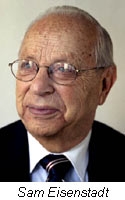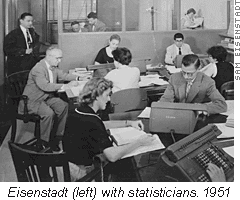CHAPEL HILL, N.C. — Sam Eisenstadt, who died Sept. 5 at the age of 98, was a giant of the investment arena.
He was research chairman at Value Line VALU, -0.68% until he retired in 2009. He had been with the firm since 1946.
His signature contribution was the creation of the famous Value Line stock-ranking system, which each week segregates 1,700 widely followed stocks into five groups according to their investment potentials over the subsequent six to 12 months. The system proved to be hugely successful: The stocks in the highest-ranked category, their Group 1, on average proceeded to beat the stocks in Group 2. In turn, the Group 2 stocks on average beat the names in Group 3, and so forth down to Group 5.

The differences in these groups’ returns were large and consistent enough that even skeptical statisticians were unable to dismiss them as pure randomness. It’s difficult for us today to appreciate how big a deal this was. In the 1960s and 1970s there was such a strong orthodoxy in academic circles that stock markets could not be beaten that professors risked their careers if they publicly harbored any doubts. But, in 1971, a prominent finance professor went on record conceding that the Value Line ranking system was a major exception.
The professor was the late Fischer Black, who at the time was at the University of Chicago. (You probably know of him as the co-author of the famous Black-Sholes options pricing model.) His concession appeared in 1973 in the Financial Analysts Journal, in an article entitled “Yes, Virginia. There Is Hope.” Black concluded “Most investment management organizations would improve their performance if they fired all but one of their security analysts and then provided the remaining analyst with the Value Line service.”
What econometric analysis was like in the 1950s and 1960s
Eisenstadt’s discovery of the Value Line ranking system did not come easily. It involved testing myriad possible correlations between numerous combinations of investment variables involving thousands of stocks over many years. Today, anyone with a laptop and a spreadsheet program can conduct one of these complex statistical tests in less than a second. In the 1950s and 1960s, just one of these tests required an army of statistical clerks working a full day operating large and lethargic adding machines that were capable of little more than simple arithmetic.

This sheer logistical challenge was imposing enough. But a perhaps even bigger obstacle over which Eisenstadt had to jump was conceptual. In an interview in 2005, he told me that in the 1940s and 1950s, no one on Wall Street “even knew what a statistician did” and so it didn’t even occur to anyone to test whether any factors had the ability to predict stock performance. As a trained statistician, Eisenstadt was tailor-made for the job.
The Value Line ranking system today
Given the Value Line ranking system’s remarkable performance, it was perhaps inevitable that it would eventually lose much of its market-beating potential. As the decades past, more and more investors began to incorporate into their strategies the factors on which the Value Line system was based—such as the longer-term trend of a company’s earnings and stock price, as well as recent earnings surprises.
Eisenstadt foreshadowed this eventuality in a debate he had several decades ago at the University of Chicago with Rex Sinquefeld, the co-founder of Dimensional Fund Advisors. Sinquefeld, who took the side of market efficiency, minimized the significance of the Value Line ranking system’s performance by saying “OK, Mr. Eisenstadt, assuming your results are as good as you claim, eventually everyone will start following the rankings and the system will cease to perform.” Eisenstadt’s response was: “As long as [business] schools kept teaching this stuff on efficient markets, there was hope for us.” (These two quotations are from Eisenstadt’s recollection in 2004).
His hope was rewarded for several more decades. Up until the early aughts, the Value Line ranking system regularly appeared in my Hulbert Financial Digest’s scoreboards for best long-term performance, on both an unadjusted and risk-adjusted basis.
Over the last 15 years, in contrast, it has struggled: The First Trust Value Line 100 ETF FVL, -1.25%, which invests in the 100 stocks rated highest by the Value Line ranking system, has lagged the S&P 500 index SPX, -0.81% by more than four annualized percentage points.
It is testament to Eisenstadt’s contributions that it took decades for the market to catch on to the Value Line ranking system. And it is further testament that what eventually sabotaged it was our implicit recognition of what he had discovered in the 1950s and 1960s.
So please offer him thanks every time you pick a stock based on its longer-term earnings and price trends or on its earnings surprises—or every time you employ rigorous statistical analysis to zero in on what truly works in the investment arena.
Mark Hulbert is a regular contributor to MarketWatch. His Hulbert Ratings tracks investment newsletters that pay a flat fee to be audited. He can be reached at [email protected].





